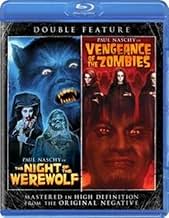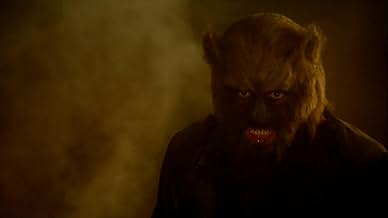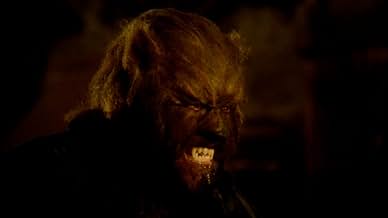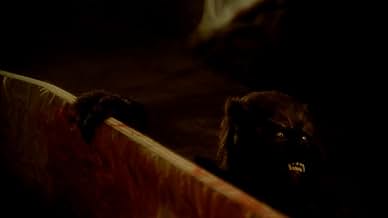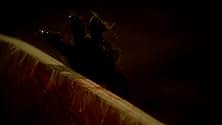IMDb RATING
5.8/10
1.2K
YOUR RATING
An evil witch brings back to life the infamous Elizabeth Bathory, who was executed several hundred years previously for murdering young woman and bathing in their blood.An evil witch brings back to life the infamous Elizabeth Bathory, who was executed several hundred years previously for murdering young woman and bathing in their blood.An evil witch brings back to life the infamous Elizabeth Bathory, who was executed several hundred years previously for murdering young woman and bathing in their blood.
- Awards
- 2 wins & 1 nomination total
Julia Saly
- Countess Elisabeth Bathory
- (as Jully Saly)
Azucena Hernández
- Karen
- (as Azucena Hernandez)
Rafael Hernández
- Yoyo - Second graverobber
- (as Rafael Hernandez)
Tito García
- First thief
- (as Tito Garcia)
- Director
- Writer
- All cast & crew
- Production, box office & more at IMDbPro
Featured reviews
I have to admit that I'm not a very big fan of Paul Naschy's "Homo-Lobo" series of films, and have disliked most of the ones I've seen. This one, however, was rather good. The film is set apart somewhat from the rest of the series because of the fact that lead star Paul Naschy also directed the film. The film was made in the early eighties; but Naschy retains the seventies feel of the previous films in the series and this one doesn't feel out of place with the rest of them, although the central character is slightly different as this time he originates from the middle ages. The film kicks off with a scene that sees Naschy's character Waldemar Daninsky and Countess Elizabeth Bathory, executed. We then fast forward a few hundred years and focus on a woman into black magic that wants to rejuvenate Elizabeth Bathory. However, upon reaching the resting place with her friends; she discovers Daninsky already awakened. She proceeds with her mission anyway, and ends up bringing the Countess (apparently a vampire) back to life.
The film could basically be summed up as 'werewolf vs vampires', as that is effectively what it turns into. I really do like Naschy's decision to feature the infamous Countess in the film; although he has been a bit liberal with the way she is used in the story. The style of the film is really great; the cinematography is interesting and the use of music is good; although slightly odd, it must be said. It does also have to be said that the film is more than just a little bit uneven; some of the set pieces are brilliant and really well worked, while other moments of the film are turgid and rather boring. The film also gets a bit sluggish towards the end and it seems like Naschy might have ran out of paper to write his script on as the final third contains hardly any dialogue. The werewolf effects are rather poor also; especially when you consider that An American Werewolf in London and The Howling were released in the same year. The film is slightly disappointing overall because with better handling it could have been really great...but even so, Night of the Werewolf is still worth a look.
The film could basically be summed up as 'werewolf vs vampires', as that is effectively what it turns into. I really do like Naschy's decision to feature the infamous Countess in the film; although he has been a bit liberal with the way she is used in the story. The style of the film is really great; the cinematography is interesting and the use of music is good; although slightly odd, it must be said. It does also have to be said that the film is more than just a little bit uneven; some of the set pieces are brilliant and really well worked, while other moments of the film are turgid and rather boring. The film also gets a bit sluggish towards the end and it seems like Naschy might have ran out of paper to write his script on as the final third contains hardly any dialogue. The werewolf effects are rather poor also; especially when you consider that An American Werewolf in London and The Howling were released in the same year. The film is slightly disappointing overall because with better handling it could have been really great...but even so, Night of the Werewolf is still worth a look.
This is the type of movie where most audiences will just laugh at the film, especially in that it is mostly dated, but people who have seen some really bad movies of this type (like me) will realize that there are actually some good things here.
The lighting and photography are generally speaking very good. There are some good mist effects and lighting effects that use the smoke and colors to create a good spooky effect a la Mario Bava.
The makeup is also quite well done for its time.
The story is the usual cr*p about vampires coming back to life, but it's kind of interesting that they threw the werewolf into it and made him sort of the good guy.
Also a lot of decent gore here for fans of that type of thing.
All in all, a film that should amuse those looking for a "golden turkey" but will also delight those who appreciate good European horror.
The lighting and photography are generally speaking very good. There are some good mist effects and lighting effects that use the smoke and colors to create a good spooky effect a la Mario Bava.
The makeup is also quite well done for its time.
The story is the usual cr*p about vampires coming back to life, but it's kind of interesting that they threw the werewolf into it and made him sort of the good guy.
Also a lot of decent gore here for fans of that type of thing.
All in all, a film that should amuse those looking for a "golden turkey" but will also delight those who appreciate good European horror.
THE CRAVING is possibly the most satisfying (if still flawed) Paul Naschy film I've watched so far: the fact that Waldemar Daninsky here originates from the Middle Ages gives the character a true mythic quality which is not possible with his usual modern-day persona; besides, his medieval 'wardrobe' (beard, coat-of-arms, crossbow and, briefly, an iron mask) is pretty cool - as is the vicious werewolf look which Naschy comes up with for this one, certainly the creepiest of his that I've seen...though, ironically enough, it doesn't see a lot of action (still, I guess, there's really so much can be done differently from one film to the next). The atmosphere (fog, candlelight, color gels) is really laid on thick here and the score, too, is pretty varied for this type of film (I even liked the rock theme heard during the opening and closing credits).
What prevents THE CRAVING from getting a *** rating from me, which would make it a solid and good picture, is a rather muddled storyline (though still the most interesting yet penned by Naschy): when the film opens, Waldemar is supposed to be Elizabeth Bathory's lieutenant but when they are revived centuries later, he is somehow hellbent on destroying her (and the army of women - there's a plethora of female characters here but, alas, very little nudity - which she manages to vampirize)!; the evil Erika, well-versed in the occult and who has no qualms about murdering her mentor, and later sacrifice her best friend in order to restore the vampire lady whom she idolizes, is set up initially as a quite formidable villain - even seducing Waldemar when a vampire - but her role gradually deteriorates to nothing, apparently so as to allow the Bathory character to take center-stage for the climactic duel between the werewolf and his arch-nemesis. Unfortunately, this sequence comes off as anti-climactic because one can hardly discern anything that's going on: either the print is too dark or it was simply filmed that way; however, the ending of this one is really bleak as Waldemar's love interest, already on her way to becoming a vampire, is infected with the curse of the werewolf as well(!) but she is quick to bring the house down in a conflagration which decimates the evil pervading the entire manor...
What prevents THE CRAVING from getting a *** rating from me, which would make it a solid and good picture, is a rather muddled storyline (though still the most interesting yet penned by Naschy): when the film opens, Waldemar is supposed to be Elizabeth Bathory's lieutenant but when they are revived centuries later, he is somehow hellbent on destroying her (and the army of women - there's a plethora of female characters here but, alas, very little nudity - which she manages to vampirize)!; the evil Erika, well-versed in the occult and who has no qualms about murdering her mentor, and later sacrifice her best friend in order to restore the vampire lady whom she idolizes, is set up initially as a quite formidable villain - even seducing Waldemar when a vampire - but her role gradually deteriorates to nothing, apparently so as to allow the Bathory character to take center-stage for the climactic duel between the werewolf and his arch-nemesis. Unfortunately, this sequence comes off as anti-climactic because one can hardly discern anything that's going on: either the print is too dark or it was simply filmed that way; however, the ending of this one is really bleak as Waldemar's love interest, already on her way to becoming a vampire, is infected with the curse of the werewolf as well(!) but she is quick to bring the house down in a conflagration which decimates the evil pervading the entire manor...
I love Paul Naschy's movies. At least his catalog of horror films. In these gems he has portrayed every classic monster (including Dracula), and never cheapened or belittled their impact on our culture. Because all of his films are Spanish productions, they all do suffer one common problem: They have to be dubbed into English to be distributed here. What's interesting is that most do translate well, and the onscreen action lends itself to understanding. Most of the time.
I first caught "El Retorno del Hombre-Lobo" late one summer evening after a trip to the video store. I was in search of B-movie excitement, and found it. The American title was "The Craving" and the box art and plot desription were amateurish at best. The movie teetered on the brink of being equally thin, but redeemed itself somewhat with the lead performances.
Naschy once again portrays Waldemar Daninski, Polish nobleman who, in this this universe, was consort to Countess Elizabeth Bathory (yes, that Countess Elizabeth Bathory). The Countess , Daninski and their followers are dragged before the local Federales and charged with the usual "unspeakable acts of depravity and witchcraft." Waldemar wimps out and accepts the judgement of the court, while the Countess hurls curses before they are all executed.
The slow pace doesn't let up. Waldemar's resurrection and subsequent full moon forays put a dent in the population and add some zest to the stagnant feel. Elizabeth's return is also a highlight, with old-school style thunder and lightning and appropriate symphonic music. Unfortunately, the excitement soon bogs down in tepid melodrama and acting class homework. The plot falls into way too familiar territory. Lead vamp resurrected; collects band of followers; menaces hero and his sweetie; comes close to actually taking sweetie away; is vanquished in knock down-drag out with hero. Slightly misogynistic overtones crop up throughout the movie: the women are evil, and that evil is the source of their power. Erica, one of the trio of hotties who come looking for Bathory's grave, is a devoted follower bent on bringing her back, while Karen, Daninski's love interest, is an ineffective crybaby. The other two women, Barbara and Mikaiya, are there for vampire fodder,and of course, end up assisting the evil. Although he nightly pillages the countryside, in gory Italian-Zombie-Flick fashion, Waldemar's affliction ain't his fault. Getting involved with the wrong woman led to his downfall. And when Karen is visited in the wee hours by Elizabeth, she gives in quite easily to the darkside (granted, this was probably an attempt by the creators to pay homage (read: rip off) Hammer's lesbian vamp movies).
This particular entry into the Daninski saga suffers from two very big problems: continuity and lighting. There were several scenes that left me going "Huh?", like the delivery of coffins in the dead of night by curious villagers. What? They just up and deliver to anybody, anytime? It was also curious that the werewolf's attacks caused so little concern, while the vampires feastings were worthy of a town elders powwow with Waldemar. The lighting was atrocious. Granted, electricity isn't too readily available in most of your Balkan countries, but still, eyestrain is not something you want viewers to leave your films with. That is, if you expect them to come back. The dubbing surprisingly didn't detract from the film; some of the translation actually fit in with the onscreen stuff.
A word about the actors. Paul Naschy/Jacinto Molina is very much Lon Chaney with a matinee idol's looks. He scripted most of these movies (and rewrote others during filming), but never cut out the other actors around him. His Waldemar Daninski is a real tragic hero, despising his condition, but so in love with life he can't put himself down. In all of the "Hombre-Lobo" flicks, no matter how he became a werewolf, he had to find and lose true love to stop the beast within. Julie Saly, who starred with Naschy in several other films, gets kudos for gracing Elizabeth with viciousness and charm. My one complaint is that she only turned up in scenes involving blood. That aside, another excellent performance. Silvia Aguilar is the real star as the conniving Erica, intent on reviving Elizabeth, and, even after being vampirized and ordered about by the Countess, taking control of several situations. The other ladies provide decoration, especially Azuncen Hernandez as the brainless Karen.
"The Craving" is an unbelievable mishmash of folklore, black magic and melodrama. But that's the beauty of these movies, I guess. Not only is belief suspended, but all forms of natural and unnatural law as well. Like the Hammer films of the 70's, each Daninski film was released in America with more and more gratuitous nudity. Most were, of course, filmed with nude scenes, and those were excised for distribution. Pretty much all retailers now offer "original and uncut" versions. I need to snag the uncut version of this one. If only to figure out why Bathory resurrected some moldy guardian that was so easily dispatched. Jeez! Why didn't you just get a dog?
I first caught "El Retorno del Hombre-Lobo" late one summer evening after a trip to the video store. I was in search of B-movie excitement, and found it. The American title was "The Craving" and the box art and plot desription were amateurish at best. The movie teetered on the brink of being equally thin, but redeemed itself somewhat with the lead performances.
Naschy once again portrays Waldemar Daninski, Polish nobleman who, in this this universe, was consort to Countess Elizabeth Bathory (yes, that Countess Elizabeth Bathory). The Countess , Daninski and their followers are dragged before the local Federales and charged with the usual "unspeakable acts of depravity and witchcraft." Waldemar wimps out and accepts the judgement of the court, while the Countess hurls curses before they are all executed.
The slow pace doesn't let up. Waldemar's resurrection and subsequent full moon forays put a dent in the population and add some zest to the stagnant feel. Elizabeth's return is also a highlight, with old-school style thunder and lightning and appropriate symphonic music. Unfortunately, the excitement soon bogs down in tepid melodrama and acting class homework. The plot falls into way too familiar territory. Lead vamp resurrected; collects band of followers; menaces hero and his sweetie; comes close to actually taking sweetie away; is vanquished in knock down-drag out with hero. Slightly misogynistic overtones crop up throughout the movie: the women are evil, and that evil is the source of their power. Erica, one of the trio of hotties who come looking for Bathory's grave, is a devoted follower bent on bringing her back, while Karen, Daninski's love interest, is an ineffective crybaby. The other two women, Barbara and Mikaiya, are there for vampire fodder,and of course, end up assisting the evil. Although he nightly pillages the countryside, in gory Italian-Zombie-Flick fashion, Waldemar's affliction ain't his fault. Getting involved with the wrong woman led to his downfall. And when Karen is visited in the wee hours by Elizabeth, she gives in quite easily to the darkside (granted, this was probably an attempt by the creators to pay homage (read: rip off) Hammer's lesbian vamp movies).
This particular entry into the Daninski saga suffers from two very big problems: continuity and lighting. There were several scenes that left me going "Huh?", like the delivery of coffins in the dead of night by curious villagers. What? They just up and deliver to anybody, anytime? It was also curious that the werewolf's attacks caused so little concern, while the vampires feastings were worthy of a town elders powwow with Waldemar. The lighting was atrocious. Granted, electricity isn't too readily available in most of your Balkan countries, but still, eyestrain is not something you want viewers to leave your films with. That is, if you expect them to come back. The dubbing surprisingly didn't detract from the film; some of the translation actually fit in with the onscreen stuff.
A word about the actors. Paul Naschy/Jacinto Molina is very much Lon Chaney with a matinee idol's looks. He scripted most of these movies (and rewrote others during filming), but never cut out the other actors around him. His Waldemar Daninski is a real tragic hero, despising his condition, but so in love with life he can't put himself down. In all of the "Hombre-Lobo" flicks, no matter how he became a werewolf, he had to find and lose true love to stop the beast within. Julie Saly, who starred with Naschy in several other films, gets kudos for gracing Elizabeth with viciousness and charm. My one complaint is that she only turned up in scenes involving blood. That aside, another excellent performance. Silvia Aguilar is the real star as the conniving Erica, intent on reviving Elizabeth, and, even after being vampirized and ordered about by the Countess, taking control of several situations. The other ladies provide decoration, especially Azuncen Hernandez as the brainless Karen.
"The Craving" is an unbelievable mishmash of folklore, black magic and melodrama. But that's the beauty of these movies, I guess. Not only is belief suspended, but all forms of natural and unnatural law as well. Like the Hammer films of the 70's, each Daninski film was released in America with more and more gratuitous nudity. Most were, of course, filmed with nude scenes, and those were excised for distribution. Pretty much all retailers now offer "original and uncut" versions. I need to snag the uncut version of this one. If only to figure out why Bathory resurrected some moldy guardian that was so easily dispatched. Jeez! Why didn't you just get a dog?
I liked this movie, although I enjoy most of Paul Nashys movies anyway I found this one special. I starts at the beginning when Countess Bathory and Nashy who is accused as a warewolf are being executed only to be brought back to life 400 years later. I liked the switch with the vampire going after the warewolf and each being enemies instead of alies with eachother. I could do without the terrible love scenes of Nashy and his lady who falls in love with him only to be bitten by the vampire and bitten by Nashy. It's worth a look, but it's not a classic.
Did you know
- TriviaThe music playing during the opening and end titles is taken from Stelvio Cipriani's soundtrack for Tentacules (1977).
- GoofsWhen vampire Erika is seducing Waldemar, the mirror above them is supposed to show no reflection. When he lifts his arms, they are not reflected at all, but the same arms. The mirror is a projection of the same scene taken without Erika in the shot.
- Quotes
Mircaya: You should watch Erika, Waldemar. Her spirit is false. She's totally evil.
Waldemar Daninsky: I know she's perverse...but she has such beauty!
- How long is The Night of the Werewolf?Powered by Alexa
Details
- Release date
- Country of origin
- Language
- Also known as
- The Night of the Werewolf
- Filming locations
- Production company
- See more company credits at IMDbPro
- Runtime1 hour 32 minutes
- Sound mix
- Aspect ratio
- 1.66 : 1(original & intended ratio, European theatrical ratio)
Contribute to this page
Suggest an edit or add missing content


